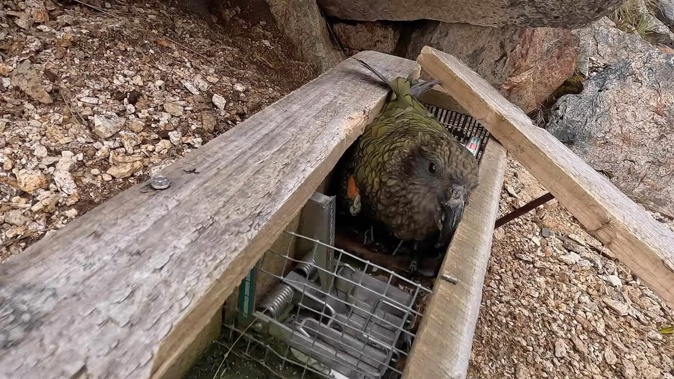
- The Department of Conservation (DoC) is defending its trapping methods despite accidentally killing some native wildlife, including kiwi and kea.
- DoC says the benefits of predator trapping ‘massively outweigh’ the risks to native species.
- Measures are in place to reduce bycatch, but some native species, such as weka and robins, are at higher risk.
The Department of Conservation is defending its trapping methods after images of a dead kiwi in a pest trap raised questions over the safety of the traps.
Five years of data collected from more than 65,000 traps between 2020-24 paints a stark picture of the risk to native wildlife, with 431 weka and 219 robins perishing in traps.
Twelve tīeke (saddleblack), eight kea, eight kākāriki (NZ parakeet) and one tuatara also died in DoC traps during that period.
DoC traps are designed to be safe for native wildlife yet attractive to target species, but DoC say as the populations of threatened species recover and increase, the number accidentally caught is likely to rise.

The live kea found in a DoC trap had a "severely damaged leg".
The data was released to the Herald by DoC and was gathered by trap.nz, an app used by trappers, DoC and community groups to record trapping catches.
DoC also released records to show 16 rare kiwi have been found dead or seriously injured in traps (DoC and non-DoC) throughout New Zealand from 2008-24.
It’s a small number in the context of how many traps were set and maintained, the department said.
“In 2022, there were more than 100,000 DoC series traps in kiwi habitats across the country – the proportion of incidents with kiwi is small,” a DoC spokesperson said.
DoC senior technical adviser Nic Gorman said the benefits of predator trapping “massively outweigh” the risks to native species.
“Removing 364,500 predators will have saved countless native birds, bats, lizards and insects from being killed and eaten.”
In 2020-24, more than 65,000 traps were active and checked at least 3.4 million times.
The traps captured more than 280,000 rats, 30,000 stoats, 20,000 possums, 20,000 hedgehogs, 9500 weasels, 3500 feral cats and 1500 ferrets.
Risk to native species cannot be ‘eliminated entirely’
Gorman recognised some native species were “at particular risk” from trap designs, and said DoC tried to find ways to mitigate this.
“For example, weka are able to access DoC series traps in ‘best practice’ trap boxes; the length and flexibility of their necks means they can reach the trap without fully entering the box.
“We counter this by requiring the use of either elongated trap boxes or trap boxes with side entrances where weka are present.”
But the risk of trapping weka chicks and small adults can’t be eliminated entirely, DoC admits.
“In locations like Abel Tasman National Park, weka populations are rapidly increasing despite the bycatch in traps.”
Gorman said for some species, the benefit of trapping outweighed the potential for harm.

A woman walking the Omahuta-Puketī forest track found a dead kiwi inside a DoC trap.
“We can’t prevent NZ robins/toutouwai from accessing rat and stoat traps, and their behaviour means that they are the most frequently caught of our small forest birds.
“However, as they are highly susceptible to being killed by rats and stoats, especially while nesting, the benefits of trapping greatly exceed the risks to the species.”
As threatened species' populations increase, the number accidentally caught would also probably increase, Gorman said.
The Herald previously reported a woman on a forest walk was disturbed to find a dead kiwi inside a DoC pest trap in late January.
“Don’t get me wrong, I love DoC and I love what they stand for and what they do, but clearly this [trap] is doing the polar opposite of what it should,” she said.
Following the Herald article, a hiker expressed concern over trap safety after finding a kea stuck in a trap at Fiordland National Park in March.
“I managed to free it, but it had a severely damaged leg ... I don’t know if the kea survived.
“I don’t think these traps are fit for purpose and suspect they kill far more wildlife than what they’re intended for.”

DoC is unsure what happened to the injured kea.
DoC senior ranger biodiversity Lydia McLean said instances of kea tampering with traps had resulted in changes to trap design over the years.
“Kea in Fiordland show considerable interest in traps and are known to follow trappers along trap lines.”
McLean acknowledged the trap that caught the kea was broken, despite being checked the day before.
“The lid of this trap box was broken. It had split along the grain of the wood which enabled the kea to access the bait and trap inside.
“Trap records from the last time it was serviced, the day prior to the kea being caught, did not indicate any damage at that time.”
The trap was removed the same day the kea was reported trapped, but DoC is unsure what happened to the injured kea.
“We understand the kea was released from the trap by the trampers who found it. No DoC staff were present to assess its condition.
“It was reportedly caught by its foot, so may have had a foot injury, but it was evidently mobile after being released.”
Jaime Lyth is a multimedia journalist for the New Zealand Herald focusing on crime and breaking news. Lyth began working under the NZ Herald masthead in 2021 as a reporter for the Northern Advocate in Whangārei.
Take your Radio, Podcasts and Music with you








